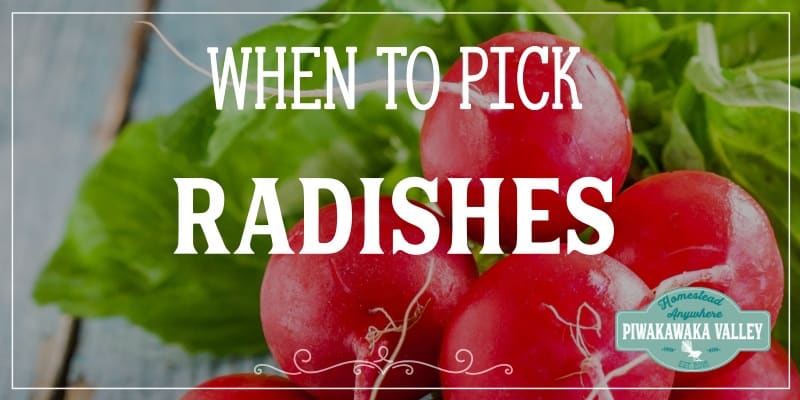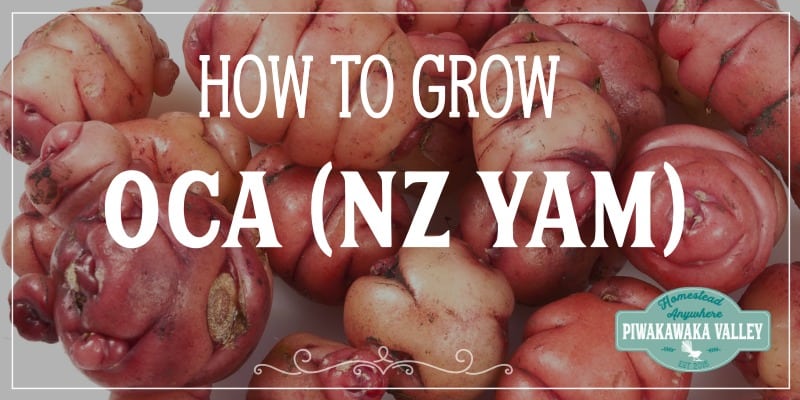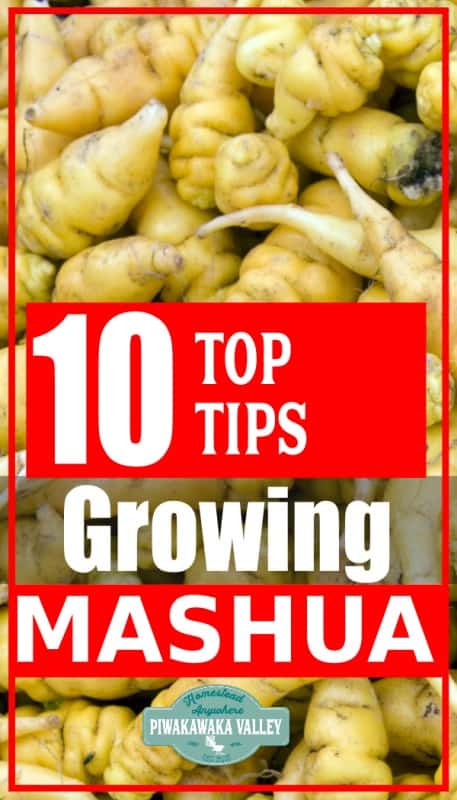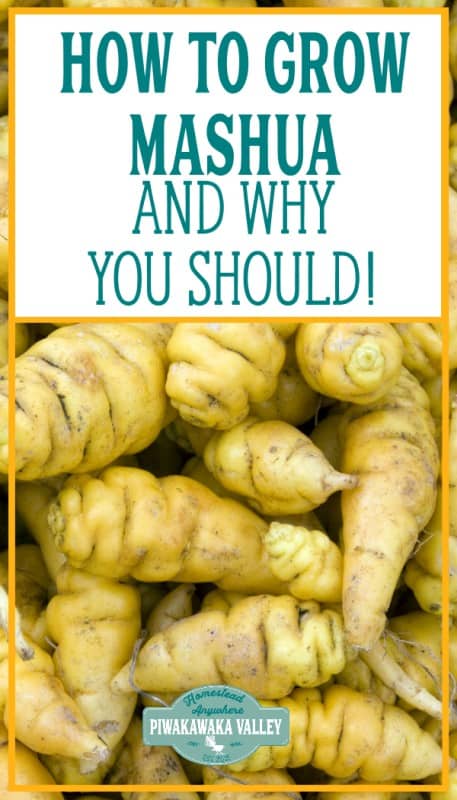This post was most recently updated on September 1st, 2020
Mashua is a tuber crop from the Andes. Mashua has been cultivated alongside oca (NZ yam), ulluco and potatoes. This native Inca crop is harder to find than some of it’s more popular friends, but it is a brilliant plant to grow in your veggie patch or food forest. Mashua is a high calorie survival crop that deserves a little more attention from the public! Read on to find out how you can grow and use mashua at your place.
Please read: This information is provided for educational purposes only and is not intended to treat, diagnose or prevent any disease. We encourage you to make your own health care decisions in partnership with a qualified health care professional.
This post contains affiliate links, this means at no extra cost to you, we make a commission from sales. Please read our Disclosure Statement
What is Mashua?
Mashua (Tropaeolum tuberosum), pronounced Mah-shwuh, is a member of the family Tropaeolaceae, along with the common garden nasturtium.
Mashua is also commonly known as tuberous nasturtium, añu, cubio, or papa amarga (not to be confused with papa amarga (bitter potato) which more commonly refers to the frost resistant potato species Solanum curtilobum and S. juzepczukii).
Related to the common nasturtium, they grow in similar conditions, so if you can grow nasturtium you can probably grow mashua at your place. The do best in areas with cooler summers that don’t go over 27C/80F very often.
Mashua has long vining stems on which three to five lobed leaves form. Later in the season, mashua forms trumpet shaped orange, orange and yellow, or occasionally red flowers.
It is an attractive plant and it is better known as an ornamental than an edible in many parts of the world.
Plants can grow up to 4m/ 12 feet tall if given something to climb. They are fast growing in cool, wet weather and are generally able to out-compete and smother weeds.
If you grow the mashua up a trellis, you could get a harvest of up to 10kg (20lb) per plant, but 2.5kg (5lb) is more normal.
Mashua tubers range widely in size, from about three inches to more than thirteen inches. They are small round, long tubers and can vary in colour from white to cream (most common) to yellow, pink or purple or streaks of any of these colours.
Mashua plants have bluish green foliage with alternate, round and peltate leaves. Each leaf consists of 3-5 lobes.
The flowers of these plants may vary from dark yellow and orange to scarlet.
The tubers have a shiny, waxy skin that cleans easily and they cluster relatively closely under the base of the plant so they are easy to harvest.
The tubers form during Autumn/Fall as the plant stores sugars before the heavy frosts kill off their tops/vines. Mashua is propagated by planting last seasons tubers in the ground, they do readily seed but do not grow true to type from seed.
Mashua History
There is evidence that exists for ancient use of mashua, as much as 8000 years ago, probably with later domestication. The first archaeological evidence of mashua use dates to roughly 700 to 1400 years ago.
Originally from the Titicaca basin of Peru and Bolivia, this crop quickly became wide spread through the Andes.
Unlike other crops like oca, yacon and maca, mashua has yet to find its world niche, and is at risk of being lost. It has already lost probably about half of its genetic diversity.
Mashua was introduced to Europe as early as 1827 but has been predominantly grown as an ornamental with little attention applied to maintaining the variation and qualities of an edible tuber.
Growing Mashua
Given a long enough frost free autumn, plenty of water, and an overall cool climate, mashua can produce very high yields. We average 5 pounds (2.3 kg) per plant, but have seen as much as 16 pounds (7.25 kg) from a single plant. Warm climate yields are smaller, reaching perhaps two to three pounds (about 1 kg) per plant.
Mashua is traditionally grown at elevations of 10,000 to 12,000 feet (3000 to 3700 m), where the average annual temperature is 11 C (52° F ).
It is poorly adapted to warm, dry conditions so it works well in most of New Zealand and is best suited to maritime climates in North America.
Mashua thrives in climates with cooler summer temperatures, where the high temperature seldom rises above 27C (80° F). If you can cater to this lower temperature, Mashua thrives in full sun, if your climate is warmer, some afternoon shade is prefered by the plant making a food forest set up ideal for it.
It needs consistent water to grow well and it would benefit from a drip system in climates where rainfall is not regular.
The plant has some resistance to light frosts, but a hard frost will kill the foliage completely. Because tubers form in the fall, this makes it unsuitable for locations with frosts that occur earlier than the beginning of May in the southern hemisphere and November in the northern.
Soil Requirements for Mashua
Mashua will thrive even in relatively poor soils, however at harvest time you will appreciate having planted it in loose, light soil.
An annual dressing of complete organic fertilizer or compost should provide mashua with all the nutrition they require.
Most of the Andean root crops respond poorly to rich fertilizers and they tend to prefer moderately acidic soils, although mashua appears to have a wide range of soil tolerance.
Sowing Mashua
Tubers will start to sprout at room temperature in late winter/ early spring.
Sprouted tubers can wait to be planted for a couple of weeks, so it is best to wait until the last frost has passed.
It is best to store the sprouted tubers where they can get some light because sprouts that grow in darkness will become long, spindly and fragile.
If it will be a while before you can get them in the ground, it is a good idea to pot the tubers so that they don’t continue to expend their reserves. You can put them in some barely damp soil with the tip of the sprout exposed and then transplant after the last frost.
Super long sprouts can be cut back, but should not be pulled from the tuber, as this often leads to rotting in the tuber and the loss of the plant.
You can cut tubers for more plants, in the same way that as you would with seed potatoes. Make sure each piece has at least two eyes. If you do cut your tubers, let them heal for a few days in a humid environment before planting them as this helps prevent them rotting before they grow.
Sow the tubers about 10cm/4in deep and 60-75 cm (2-3ft) apart if growing in traditional plant mounds, or 30cm/1ft apart if allowing to sprawl or grow up a trellis. Trellis rows of 1.5m/5ft apart will allow you walking space between.
Growing Mashua
If your mashua is unsprouted, you can plant it up to 3 weeks before your last frost, sprouted tubers should wait until after your last frost date.
In Winter or early Spring you can loosen the soil, clear the weeds and amend with some well rotted compost or manure.
Traditional Andean culture of mashua does not appear to have involved any trellising. Instead, the plants are just allowed to pile on top of the ground, forming a mound with about a two foot (60 cm) radius. Mashua can make a very good weed suppressing crop when grown in this fashion.
Like potatoes, mashua is typically hilled up at least once during the growing season. This doesn’t appear to improve yield, but it does protect the forming tubers from exposure as they grow right at the surface of the soil, and exposed ones will go green and are not suitable for eating (though they can be used to grow new plants).
If you get early frosts, a thick layer of mulch will help keep the plant alive as long as possible and improve the size of your tubers.
Mashua needs at least 10 weeks of growing season to get a harvest. Colour develops late in mashua tuber growth. This doesn’t matter for white varieties, but strongly coloured varieties need to be left to mature as long as possible to develop their wonderful colours.
Propagating Mashua
Mashua is commonly grown from tubers, this will grow a clone of the parent plant. The do also readily set seeds, and can be grown from seed, but they do not grow true to type from seed – this is probably how all the varieties developed.
Save the largest tubers for replanting next season. Larger tubers will store better and generally produce bigger plants faster, with more stems, which leads to greater yield.
Tuber crops are also prone to somatic mutations, so you can inadvertently select for varieties that produce smaller tubers by repeatedly planting the smallest tubers year after year.
Mashua seeds have slow and irregular germination and are not a reliable option.
If you choose to grow from seed, start at least three months before you want to transplant them out.
Sow seeds about an inch deep and keep between 12-15C ( 55 and 60 degrees F). Warmer temperatures inhibit germination.
Soil should be kept damp but not wet.
You may see germination within a month, but most will take longer.
Due to the hard shell on the seeds scarification techniques, like chipping the seed with a nail clipper or filing will improve germination time.
Taking cuttings of mashua
Mashua can also be propagated by cuttings.
Take six to nine inch sections of stem and place the bottom 2-3 inches deep in damp soil. Root formation takes four to six weeks, after which the new plant can be hardened off and moved outside.
Do not attempt to pull the full stem free of the tuber like you would with sweet potato slips because unlike most of the other Andean tubers, mashua responds very poorly to this technique and the tuber will often rot once you have pulled the dominant sprout.
Growing Mashua in a container
Mashua makes a great container plant, especially in hanging baskets where the long vines will drape and flower. Be sure to keep them very well watered.
Harvesting Mashua
Tubers will not start forming until your daylight hours are less than 14 per day. So as your chickens slow down their laying, your mashua will start forming tubers.
After your first few heavy frosts kill off the top of the plant it is time to harvest the tubers. Simply dig in the top few inches of the soil and remove all the tubers.
You can leave a few of them there to regrow for next season, but if you don’t want mashua there next year you will need to be sure to get out every single tuber!
The greens can be left to rot in place, fed to pigs or chickens or added to the compost pile.
Traditionally mashua is then left out in strong sun for 2 days to 1 week to develop their sweetness before moving to storage.
If you are expecting a very heavy frost, harvest the tubers before it arrives, because the tubers are close to the surface they will freeze easily and a frozen mashua tuber is a ruined tuber.
Pests and Mashua plants
Generally the worst pest you will find is the white cabbage butterfly’s caterpillars who will feast on the leaves. Flea beetles and aphids can also cause problems, although they aren’t so common.
Field mice or voles will dig and eat the shallow tubers as the days cool and there is less around for them to eat.
Deer also enjoy a nibble of the leaves as do geese, who may even venture in and get the tubers as well.
Powdery mildew, mosaic virus and other fungal or viral conditions can affect mashua though they are largely a disease resistant plant.
Storing Mashua
The tubers will keep 6-8 weeks when stored at room temperature and for a couple of months when stored in ideal conditions in a cool, dark, and humid space.
Mashua tubers dehydrate quickly, so they do better stored in soil than exposed to the air check out my post on storing carrots without a fridge for an idea on how to store mashua outside.
If you are keeping them dry inside, keep them in a dark, cool place and check on them from time to time.
If you find that they are becoming soft, either put them in some barely damp soil or in the crisper of your refrigerator where it is more humid and cold.
At best a storage life of six months is about the most you will get out of them.
Stored at room temperature mashua will start to sprout in early spring, which is the perfect time to get them in the ground.
Eating Mashua
You can eat mashua tubers raw or cooked. However it is more common to eat mashua cooked, after which the flavor can range from strongly cabbage like and bitter to mild and sweet.
Raw, they’re like an extra hot, crunchy radish with a hint of smoky aniseed to them. Cooking transforms them to a soft, creamy texture with a slightly aromatic, starchy fennel flavour. Roasted mashua is delicious.
The tubers for mashua are surprisingly high in vitamin C and protein for a root crop (1).
Using Mashua Raw
The tubers can be used fresh, sliced or grated thinly and sprinkled over salads for a spicy, crunchy flavor, sliced into coleslaw, or even pickled for extended use.
Lacto-fermented mashua changes in flavour profile yet again, and it benefits from this process making it quite delicious.
Using Mashua Cooked
You can treat mashua tubers like potatoes – boil, steam or roast unpeeled tubers until fork-tender. They are delicious roasted in meat drippings with a roast dinner.
Mashua can be boiled, frozen, and consumed as an unusual dessert or soaked in honey and molasses for added sweetness if you are up for an adventure.
The tubers can also be cubed and incorporated into stews, soups, and curries. Mashua works well in strongly spiced dishes such as Indian food, especially with the spice cumin, and are typically cooked with fatty meats to add flavor.
Mashua pairs well with honey, cumin, coriander, cinnamon, lemon juice, shrimp, poultry, pork, beef, tofu, sweet potato, mushroom, squash, corn, rice, and black beans.
Using Mashua Leaves
You can even eat the leaves which taste a lot like mustard greens and the flowers which have a sweet anise flavour. The leaves are commonly added to salads, used as a green wrap, or are boiled and served as a side dish.
There could be great potential in the development of mashua as a perennial leaf crop in a food forest setting.
Medicinal use of Mashua
This tuber crop has antibiotic and diuretic properties. It is believed to be able to cure skin ulcers and also to kill lice.
Mashua consumption may be protective against some kinds of cancer (2), due to its high levels of some mustard oils (glucosinolates, isothiocyanates and isothiocyanates) and these same properties can have antibiotic and insecticidal properties .
Traditionally mashua is touted as an aphrodisiac. However, studies have shown that mashua can cause both reduced sperm count (3) and lowered testosterone (4) so proceed with caution if you are trying to conceive.
Cooking breaks down isothiocyanates and this reduces or eliminates the anti-metabolic or anti-nutritional factors present in raw mashua.
Using Mashua as a fodder crop
Peasants in many South American countries feed their pigs with these rhizomes or bulbs.
These plants are recommended for livestock feed as the roots contains high levels of carbohydrates while their foliage is rich in protein.
If you would like help getting the most out of your garden, I would love to help you, find out more here
RELATED: Free Gardening Resources
If you like tips on frugal living, self sufficiency and consuming less, sign up to our newsletter below, I would LOVE to have you
For further reading, I really recommend all of these books. I own every one of them and they are amazing resources!






























